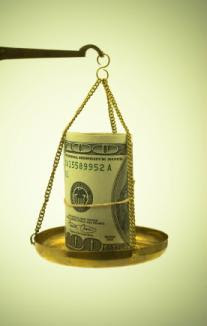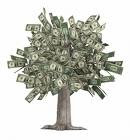
By Chris Johnson and Jon Lewis.
There are few constants in the market and even fewer things you can rely on. Everyone searches for those constants, those reliable indicators that provide an edge. But they're hard, if not nearly impossible, to find.
There is, however, one constant that you can count on. It happens throughout the year, although it's more concentrated during four quarterly "seasons." We're talking, of course, about earnings, the mandatory quarterly reports required of all publicly traded companies.
#1 The Earnings Season Trade
We say earnings "season" because that's the convention (although as you'll find out, we tend to avoid "convention"). "Official" earnings season typically kicks off with Alcoa (AA) during the first or second week of January, April, July and October.
For the ensuing month, the majority of S&P 500, Dow Jones Industrial, and Nasdaq 100 companies will report their earnings for the previous quarter. In fact, two-thirds of the S&P (330 companies) usually report within four weeks of Alcoa's announcement. Many will also provide outlooks for the following quarter and possibly the full year as well.
Actually, earnings reports hit the tape throughout the year. Sure, there are dead spots during a quarter, but they don't last long. For instance, many major financial companies report in mid-quarter, while results from retailers are spread throughout the quarter.
The bottom line is that earnings provide trading opportunities all year round, with certain periods being heavier than others.
So what's the big deal?
Earnings create expectations. They create volatility. They create trading volume. And they do it like clockwork -- four times every year -- for every stock on the market.
That's a lot of opportunities.
#2 How Does This Increased Activity Translate Into Real Dollar Gains?
Just consider these moves in some of today's most heavily traded stocks:
In July 2006, Yahoo! (YHOO) fell 21.8% after earnings were released.
During the same earnings period, shares of Apple (AAPL) shot up 11.8% in a day.
In April 2008, Google (GOOG) gained 20% the day after earnings.
Cisco (CSCO) dropped more than 9% the day after reporting first-quarter earnings in November 2007.
Amazon (AMZN) popped 24% after second-quarter earnings in 2007.
In 2008, Research In Motion (RIMM) gained an average of 12.6% on the day after each quarterly report.
Keep in mind that these gains were possible only if you had been on the right side of the move and were holding shares. At the same time, those holding the right options on these stocks could have made a fortune. (We'll talk more about options a bit later.)
If there's one thing investors want to see in their investments, it's movement. And there is no better time to see movement in share prices than during earnings season.
#3 Finding the Movers ... "Expectations"
So, how do you know which stocks are going to move?
The answer lies in expectations. It's not whether a company beats earnings estimates; it's whether they beat the market's expectations. This is a time when the reaction to news is more important than the news itself.
In fact, in 2008, Microsoft (MSFT) beat the Street's consensus earnings estimate by four cents and three cents. But two weeks after each report, the shares had dropped 15% and 8%. On the other hand, Qualcomm (QCOM) missed by a penny in January, and the stock spiked more than 10% higher in just one day.
#4 Why Does That Happen To Earnings?
Let's say the market is expecting a blowout earnings report from a particular company and many investors have purchased call options in anticipation of great earnings.
At that point, it becomes very hard for the company to impress the market and for the stock to climb. Even if the company meets or beats estimates, most of the buyers are already on board. So there's no one left to push up the price.
Investors who bid up the price of a stock or buy call options ahead of earnings don't take too kindly when a company merely meets estimates. They want more.
Once the report is made public, if the stock fails to move very much, those who anticipated a big gain begin selling. As other shareholders see the price falling, they too begin to sell.
That's why knowing the true expectations of investors (as gauged by what people are actually doing with their money) is so important around earnings season.
#5 The Key to Earnings Analysis
There are all sorts of ways to analyze the market. Everyone knows about fundamental analysis -- earnings, interest rates, P/E ratios, innovative products, etc. And most are aware of technical analysis -- charts, moving averages, trends, momentum, etc.
These are fine tools, but almost everyone is aware of them. So does that really provide an edge? After all, isn't an edge an advantage? How can you have an advantage doing what everyone else is doing?
Ultimately it comes down to the people doing the buying and selling. And it's their desires or sentiment that dictates their behavior that determines whether to buy or sell.
That's where we gain our edge. By analyzing sentiment, we can derive a predictive model of the resulting behavior that will be displayed toward a stock. Fundamentals and technicals (the tools used by most to define their "edge") are inputs to the model, but they're not sufficient. We add sentiment, measured both qualitatively and quantitatively, to give a behavioral picture of how a stock should move. In other words, we use this model to value a stock based upon its behavioral characteristics.
#6 Investor Sentiment
So what is sentiment and why is it so important? Investor sentiment is simply the collective feelings and actions of those in the market. We've found that the most-accurate sentiment indicators generally reflect what investors are actually doing (what they're buying or selling) rather than what they're feeling and saying (poll results), although both have validity in our analysis.
We've all seen a stock drop in price despite an earnings report that met or even beat expectations. Or one that rallies furiously after merely meeting expectations. Why does the stock seemingly move against the fundamentals?
Two kinds of investor sentiment usually lead to stocks moving against the fundamentals:
Excessively Bullish Sentiment: A stock with relatively low expectations (pessimism) stands a good chance of rallying, as there is plenty of sideline cash available to boost the price.
Excessively Bearish Sentiment: High expectations (the crowded trade) can put downward pressure on a stock, as there is little to no sideline cash to drive the price higher. In fact, the path of least resistance for cash is to flow out of the stock, resulting in declining prices.
#7 Look for the Contrary Indicator
Sentiment can be a contrary indicator. And the power of sentiment is much greater when it runs counter to the direction of the stock (pessimism during an uptrend, optimism during a downtrend).
The key to finding the most-optimal earnings plays is to find situations in which expectations are either high or low, and are running counter to the technicals. This is especially important during earnings season, because sentiment tends to be polarized prior to an announcement.
High expectations (low put/call ratio, low short interest, and high percentage of analyst "buy" recommendations) usually require a company to blow out earnings in order for the stock to rally. Such stocks are vulnerable to disappointments if the company simply meets estimates or issues a tepid outlook for next quarter.
Low expectations (high put/call ratio, high short interest, and a low "buy" rating percentage) mean that a stock will not have to work as hard to overcome sentiment. Such stocks are less crowded, and thus have a greater potential to rally.
Thus, capturing the sentiment backdrop prior to earnings, along with assessing the technicals and the company's past earnings history, are the keys underlying your success.
Let's examine some of these indicators and how you can use them to improve your earnings trading results.
#8 Put/Call Ratios
We've found that using option data is an excellent way to measure sentiment. We have found that option volume and open interest (the number of open contracts on an option at the end of each day) data in the form of a put/call ratio is one of the better ways to quantify investor sentiment. This straightforward indicator tells whether a stock is poised for a rally based upon large amounts of potential buying strength (as a result of the crowd leaning too far to the bearish side of the market), or poised to stall out due to a lack of cash available to push it higher (a result of leaning too far to the bullish side).
High put/call ratios often indicate excessive pessimism that translates into large amounts of money on the "sidelines."
Low put/call ratios indicate a point at which there is so much optimism that very little money is left to push the market higher (i.e., a crowded trade).
By comparing the current put/call ratio to previous readings for that stock, we can accurately gauge relative levels of investor optimism and pessimism. This is extremely important because we have found that the absolute ratio readings can vary substantially from stock to stock.
Thus, comparing an equity's ratio to previous ratios sets up an "apples to apples" comparison that provides a truer picture of relative sentiment for that particular stock Higher relative ratios indicate more pessimism (which can have bullish implications), while lower ratios suggest optimism (potential bearish implications).
#9 Short Interest
Monitoring short interest is an effective method for deriving valuable sentiment data for stocks. Short interest is created when an investor sells borrowed stock. The strategy is profitable when the price of the shorted stock declines, allowing the short seller to buy the stock back at a lower price.
As short interest is a bearish strategy, monitoring semi-monthly short-interest figures provides a glimpse of the level of pessimism toward a security. In most instances, large amounts of short interest indicate a negative general outlook.
Besides serving as a contrary indicator, short interest has a mechanical component that an investor can exploit. If a stock's price is rising, short positions are losing money (in fact, short players have unlimited risk). This often causes the shorts to close their positions by buying back their shares. This added buying pressure forces the stock price even higher (known as a "short squeeze"), which in many cases makes the uptrend persist longer than most would anticipate.
We especially like heavy short interest on a stock displaying strong price action with pullbacks contained at key support levels. This is where you will potentially see quick, significant moves caused by short-squeeze buying among the shorts looking to limit their losses.
#10 Analyst Ratings
A sentiment measure that is more easily tracked is the composite analyst rating, which is available from many major financial Web sites. These ratings simply track the total number of analysts who designate a particular stock as a "buy," "hold" or "sell." Though the vast majority of ratings fall on the "buy" side (something the industry is roundly criticized for), we'll often see a smattering of "sells" that typically reflect a fairly strong degree of negative sentiment toward a stock.
On the other hand, a heavy weighting of "buys" means that optimism is at a peak and that there is much more room for downgrades than upgrades. In other words, the ratings are as optimistic as they are likely to ever be. This can be a warning sign, especially for a stock showing technical weakness.
#11 Putting It All Together
At this point, it should be clear that sentiment is a crucial ingredient to analyzing a stock. So how do you combine sentiment, technicals and fundamentals within our behavioral analysis framework to pick a winning earnings play?
For bullish trades, look for stocks in uptrends with strong fundamentals (e.g., strong earnings growth or new product innovations) that are the target of negative sentiment.
Of course, you have to understand that the indicators will rarely all line up the same way and that stocks behave differently given a particular sentiment environment. It's the job of the "behavioral analyst" (you) to distinguish the relative level of sentiment based on the tools above and then compare the strength of the contrary indicator to the stock's technical strength and fundamental health.
Keep in mind that behavioral valuation works on the bearish side as well. Weak technicals (running into a declining 50-day moving average) and fundamentals peppered with optimistic sentiment is a bearish combination. It's only when pessimism reaches an extreme and most everyone has thrown in the towel that a tradable bottom can be formed.
Knowing what investors are doing with their money and what their expectations are ahead of earnings allows us to form an assessment of the downside risk vs. upside risk. And it allows us to make highly accurate bullish or bearish recommendations for stocks ahead of their earnings reports.
#12 Leveraging the Earnings Advantage
While buying or shorting stocks based on earnings should provide handsome returns, the real money is made by buying call options on stocks that are due for a sharp move to the upside ... and buying puts on those that are likely to disappoint. The leverage provided by short-term options (we usually recommend options due to expire within a month for earnings plays) can be dramatic if the stock moves sharply in the expected direction.
But why should you consider options? Actually, there are several reasons to trade them for any portfolio.
The Case for Trading Options in Your Portfolio
1. Limited dollar risk: It costs far less to lease the movement of a stock (either up or down) using options than an outright purchase or short of a stock. And the amount you pay for an option is the most you can lose on a trade. Thus, your potential maximum dollar loss is limited.
2. Leverage: This is probably the most-attractive and well-known benefit of options. For those who are pleased to capture a quick 10%, move in a stock, they often could have made 50%, 100%, or more by buying an option on that stock.
3. Accessibility: Option profits are available in virtually any type of market. Strategies of buying and selling options alone or in combination can produce sizable profits in up or down markets, trading ranges, volatile or non-volatile markets, etc. You name the market environment, and we're willing to bet that there's an option strategy that can profit from it.
Good investing, kingsley.













